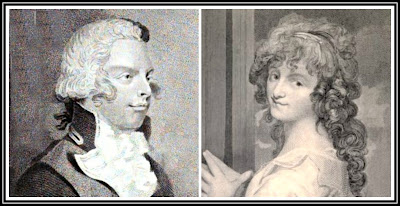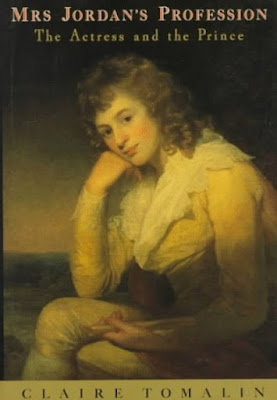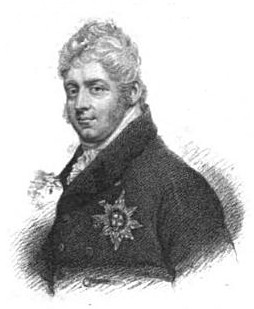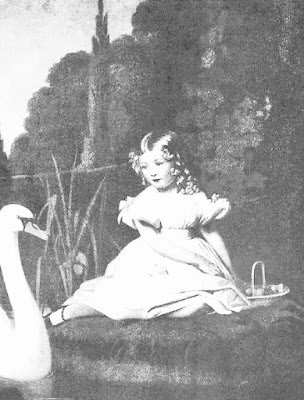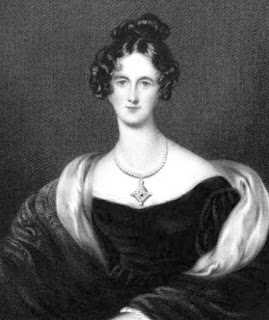 |
Mrs Jordan from The Life of Mrs Jordan
by J Boaden (1831) |
Profile
Dora Jordan (22 November 1761 – 5 July 1816) was a Georgian actress famous for her comic roles. She was the long-standing mistress of
William IV when he was Duke of Clarence.
Early years
Dorothy Bland was born on 22 November 1761, the daughter of Francis Bland and Grace Phillips. Dorothy—or Dora as she liked to be called—was born in London, although her parents normally lived in Ireland. Grace was an actress and Francis’ father—a judge of the Prerogative Court in Dublin—disapproved of the connection and had the marriage declared void as his son was under age.
Grace was devastated when, in 1774, Francis Bland deserted his family and went to London where he married an Irish heiress. Dora went to work for a milliner in Dublin and during this time, she received a proposal of marriage.
 |
Dora Jordan etched by G Meunier
from Romney from The Life of Mrs Jordan
by J Boaden (1831) |
Dora takes to the stage
Dora was soon attracted to her mother’s profession and went to work at the Crow Street Theatre in Dublin, first appearing as Miss Lucy in Henry Fielding’s The Virgin Unmasked in 1779. She met Lieutenant Charles Doyne in Waterford whilst she was on tour and he proposed marriage, but he was refused, probably because she was enjoying some success on the stage.
Dora came to the notice of Richard Daly—the manager of the rival Smock Alley Theatre—and in 1781 she joined his company. (1) In retrospect, this was a sad mistake; Daly seduced Dora and she became pregnant with his child in February 1782.
 |
Mrs Jordan as Sir Harry Wildair
from Mrs Jordan, Child of Nature
by PW Sergeant (1913) |
Crossing the Jordan
Eager to help Dora to escape from the abusive Daly, Grace took her family to Leeds where her sister was an actress in Tate Wilkinson’s Yorkshire company. Out of sympathy, Wilkinson gave Dora an audition and he was immediately entranced. Dora first appeared in his company on 11 July 1782. As her pregnancy progressed, clearly her stage name of “Miss Francis” would not do. Wilkinson suggested a new name. He likened Dora’s crossing the Irish Sea to escape Daly and work for him to the Israelites in the Bible crossing the River Jordan, and so Mrs Jordan was born.
Dora toured Yorkshire with Wilkinson’s company. One admirer, Cornelius Swan, a critic and Shakespearean scholar, coached Dora and paid off Daly who tried to get Dora arrested for breaking her agreement with his theatre. Fanny was born in November 1782.
The Country Girl
In 1785, Dora got her big break: she was offered £4 a week to go to Drury Lane in London. Her first performance took place on 18 October 1785. Her role was that of the Country Girl—a part that she had observed and determined to make her own. By the end of the year, she was offered a four year contract by the management of the Drury Lane Theatre, headed by
Richard Brinsley Sheridan.
She received another proposal of marriage, from a fellow actor from her Dublin days, George Inchbald, but Dora refused. She was in love with Richard Ford, the good looking son of one of the investors in the theatre who was aiming for a career in Parliament. In 1786, they set up house together in Bloomsbury.
The press was unkind, churning up the past, caricaturing Dora and Daly as Mrs Tomboy and the Irish Manager. Dorothea Maria, known as Dodee, was born in 1787, followed by a son who did not live in 1788 and another daughter, Lucy, in 1789. By this time, Dora was an acclaimed actress earning £30 a week for three performances—the same as Mrs Siddons.
 |
Mrs Jordan as Peggy
in The Country Girl
from Mrs Jordan, Child of Nature
by PW Sergeant (1913) |
The Comic Muse
Dora Jordan’s most famous roles were Rosalind in Shakespeare’s As You Like It, which she played in London regularly from 1787 to 1814; Hippolyta, the heroine of She would and She would Not by Colley Cibber; and The Country Girl in Garrick’s adaptation of Wycherley’s Country Wife, which she played regularly at Drury Lane from 1785 to 1800 and occasionally up to 1814.
Life as an actress was not only physically demanding; it could also be dangerous. Whilst touring in Sheffield in 1782, Dora was nearly killed by falling stage machinery. Later, whilst in Margate in August 1802, Dora’s costume caught fire.
 |
Mrs Jordan as The Comic Muse
from Mrs Jordan, Child of Nature
by PW Sergeant (1913) |
What was Dora like?
Dora was not classically beautiful, but she had a very good figure and when dressed as a boy she was considered very seductive and had an excellent pair of legs. She was short-sighted and carried her spectacles on a chain around her neck.
 |
Mrs Jordan as Hippolyta
from Mrs Jordan, Child of Nature
by PW Sergeant (1913) |
A royal admirer
In 1790, Dora began to be pursued by William, Duke of Clarence, later William IV. Dora was flattered and amused, but did not take him seriously. Rather, she hoped that the Duke’s interest would persuade Ford to marry her. But Ford was not to be forced and seemingly did nothing to persuade Dora to stay. Although initially Ford was very keen to have custody of his older daughter, within five years he had married and fathered a legitimate son and lost interest in his children by Dora.
The Duke and Dora
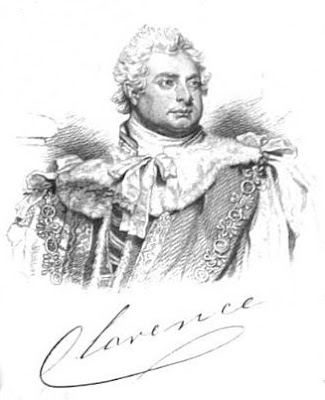 |
William, Duke of Clarence,
from A Biographical Memoir of Frederick,
Duke of York and Albany by John Watkins (1827) |
When Dora began to respond favourably to the Duke’s advances, they encountered a violent reaction from the public. The press suggested that Dora had abandoned her children to play mistress to the Duke and prints were published ridiculing the couple, depicting Dora as a chamber pot, which was, most unfortunately, known as a jordan. However, once they were known to be living together, the press seemed to lose interest.
Dora was awed by the Duke’s royal status and attracted to his warm, passionate nature. On her side, Dora was very maternal and provided a centre to the Duke’s life which he had lacked since leaving active naval service. Dora gave him good advice and managed to persuade him to virtually give up drinking, except when he was with his brothers. She also looked after him, especially during the summer when he regularly suffered from a severe asthma attack.
In November 1791, the Duke made a legal settlement on Dora, but she continued her career on stage, successfully overcoming the public’s initial hostility.
The Fitzclarences
The Duke and Dora had ten children together: George, later 1st Earl of Munster (1794), Sophia (1795), Henry (1797), Mary (1798), Frederick, known as Fredddles (1799), Elizabeth, known as Eliza (1801), Adolphus, known as Lolly (1802), Augusta, known as Ta (1803), Augustus, known as Tuss (1805) and Amelia, known as Mely or Milly (1807).
 |
George Fitzclarence, 1st Earl of Munster
from Mrs Jordan, Child of Nature
by PW Sergeant (1913) |
Bushy Park
In January 1797, George III made the Duke of Clarence the Ranger of Bushy Park. The appointment came with Bushy House, which became the family home. Like his brother George IV, the Duke was continually making alterations to the house and employed the architect Sir John Soane to plan the initial redevelopment.
The Duke’s son, William, by a previous relationship may have lived at Bushy or he may have just been a frequent visitor, as was FitzErnest, the Duke of Cumberland’s illegitimate son.
 |
Bushy House from History of the life and reign
of William the Fourth by R Huish (1837) |
Dora’s generosity
Dora had a generous spirit and often took part in benefits (2) for those less fortunate than herself. It is likely that a free school for girls near to Bushy was founded by her, as was a Female Friendly Society. She provided for her eldest daughters out of her own earnings, giving them substantial dowries, but unfortunately, this attracted suitors who subsequently took advantage of her goodwill. Dora’s brothers and her two eldest daughters’ husbands were a constant drain on her finances.
A royal separation
By the end of 1810, Dora’s relationship with the Duke was failing. They spent little time together at Bushy and the Duke was yearning for the financial freedom that marriage to a rich wife would bring him. During the summer of 1811, the Duke ardently pursued the fabulously wealthy Catherine Tylney Long. His suit was unsuccessful, but his relationship with Dora was over.
The Duke and Dora separated and a financial settlement was finally drawn up on 23 December 1812, laying out what Dora would get for herself and the children, part of which was dependent on her not appearing on stage. Reluctantly, Dora decided it was best for all the children to stay at Bushy Park with their father, whilst she continued her acting career.
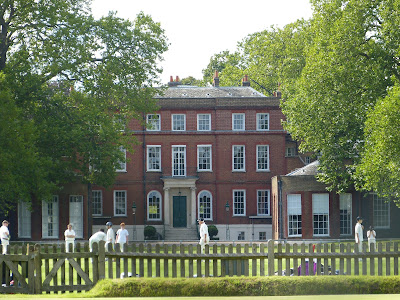 |
Bushy Park (2014)
|
Destitution and death
Dora’s financial situation did not improve. She was besieged with debts run up by her family in her name. In 1815, fearful of arrest, she agreed to go abroad to Boulogne to escape her creditors whilst John Barton, one of the Duke’s advisors, arranged her affairs. Barton let her down. He failed to act on her behalf and Dora was forced to remain abroad, apart from her beloved children, whilst her health deteriorated.
She moved to Versailles and then to Saint-Cloud, near Paris, where she died on 5 July 1816. She was buried in the cemetery of Saint-Cloud on 13 July. A few years later, a visiting English couple were moved to provide a memorial stone for her grave, but the funeral dues remained unpaid.
A lasting memorial
In 1818, two years after Dora’s death, the Duke of Clarence married Princess Adelaide of Saxe-Meiningen and in 1830, at the age of 64, he became king. When Dora died, it is reported that the Duke did not even remark on her death to her children, but she was never truly forgotten. When he became King William IV, he commissioned Sir Francis Chantrey to create a marble statue of Dora as a memorial to be placed in Westminster Abbey. Although his plans for siting the statue were thwarted, the intention was obvious—he meant to honour Dora Jordan as if she had been his queen. (3) It is sad that he did not take more care of her when she was alive.
Rachel Knowles writes clean/Christian Regency era romance and historical non-fiction. She has been sharing her research on this blog since 2011. Rachel lives in the beautiful Georgian seaside town of Weymouth, Dorset, on the south coast of England, with her husband, Andrew.
Find out more about Rachel's books and sign up for her newsletter here.
If you have enjoyed this blog and want to encourage me and help me to keep making my research freely available, please buy me a virtual cup of coffee by clicking the button below.
Notes
(1) These dates are from Tomalin; Ranger states that Dora made her theatre debut with the Smock Alley Theatre on 3 November 1779.
(2) A benefit was a special theatrical performance, the proceeds of which went to a particular actor or actress or a charitable cause.
(3) Tomalin records that the statue was refused a place in either Westminster Abbey or St Paul’s Cathedral and passed to the 1st Earl of Munster. It was bequeathed to the Queen in 1975 and is now on display in the Picture Gallery of Buckingham Palace.
Here is the link to the statue in the Royal Collection.
Sources used include:
Boaden, James,
Life of Mrs Jordan including original private correspondence (1831)
Ranger, Paul,
Jordan, Dorothy (1761-1816), Oxford Dictionary of National Biography (Oxford University Press, 2004; online edn Jan 2006, accessed 8 July 2015)
Sergeant, Philip W,
Mrs Jordan, Child of Nature (1913)
Tomalin, Claire,
Mrs Jordan's Profession - the story of a great actress and a future king (1994)
